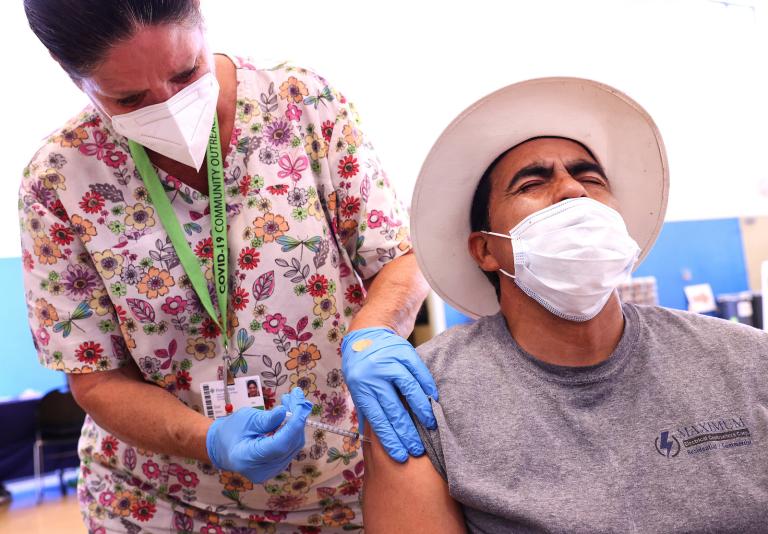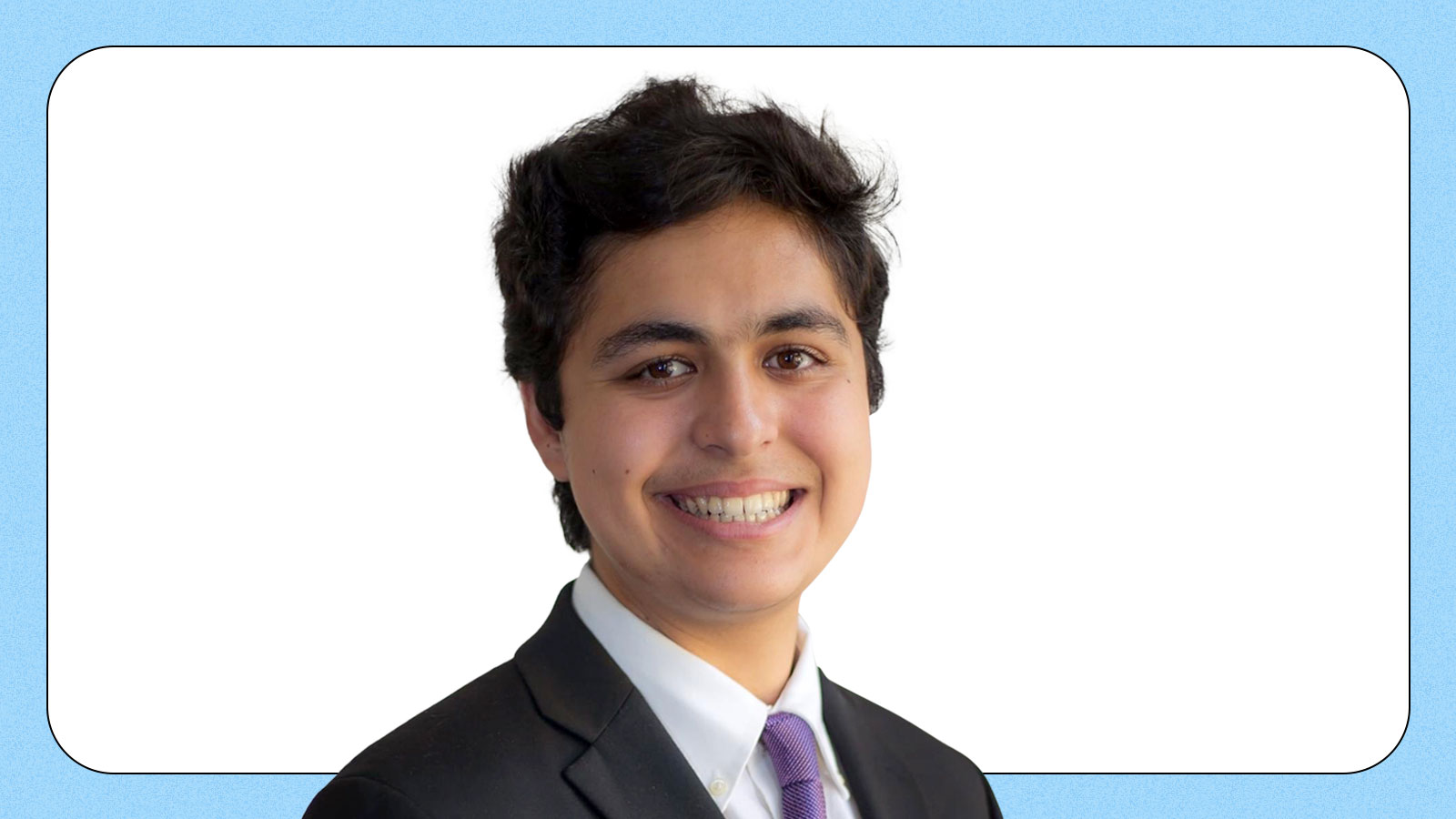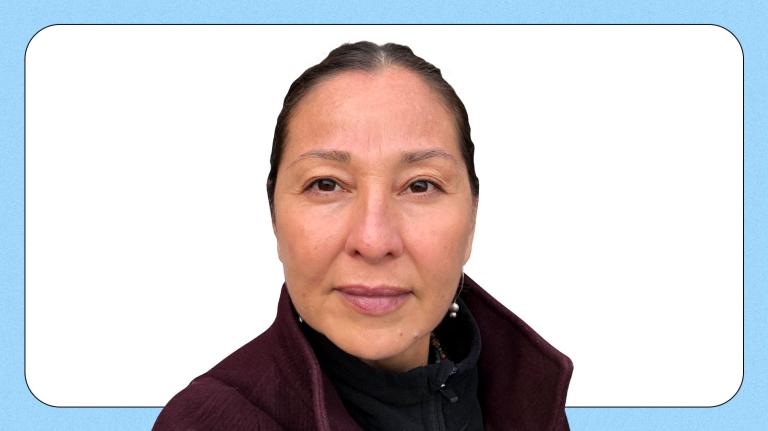This is Season 3 Episode 4 of Grist’s Temperature Check podcast, featuring first person stories of crucial pivot points on the path to climate action. Listen to the full series: Apple Podcasts | Stitcher | Spotify
“Young people, we feel a lot of pressure. What can we do? Like, I got to hold all these corporations accountable. I got to, you know, stop greenhouse gas emissions, like, what’s my carbon footprint, all that sort of thing. There’s so much to do. And so what READYteens was just trying to do is give them one tangible opportunity to respond in the event that, you know, one of these disasters happens. And the likelihood is increasing.”
– Hamid Torabzadeh
Episode transcript
Hamid Torabzadeh grew up experiencing the impacts of climate change, and in high school, he found a club that showed him his path to doing something about it. Now he’s at Brown University, studying to be what he calls a “new type of doctor” in the field of climate health. This is his story.
My name is Hamid Torabzadeh. I’m 18 years old and currently a student studying public health at Brown University.
My parents immigrated from Iran many years ago. They were both pursuing higher education in the United States and were trying to find opportunities they couldn’t find in their own country. So from the very beginning, I think it was very important for me the value of higher education, the value of education as a tool for economic opportunity, for social mobility, for other opportunities.
My dad’s a professor at Cal State Long Beach, and he’s been teaching engineering for over 30 years. His number one passion is really inspiring other students, teaching other students, mentoring other students. You know, growing up, I was very much involved in the academic space from a young age. I remember, like every summer, not only would I have summer camps on his university campus in Long Beach, but I’d go to his office, I’d see him run meetings, I’d see him talking with faculty members and his colleagues. I was just inspired, I think, by my dad’s commitment to something. He had such a clear passion for what he was doing and I wanted to do something similar in my life.
So I grew up in Long Beach, California. Long Beach is home to – combined with Los Angeles Port – what makes up 40% of all goods and imports in the country. And so it’s a very robust port. And if you just go to Long Beach, you’ll see our beach is not, you know, as great as other cities or, you know, our air quality is actually one of the worst in not only Southern California, but nationally, because of the port. And so as a child, I suffered from asthma. I had to use an inhaler for several years. And, you know, what doctors said at the time and probably a reasonable conclusion is because of the air quality.
Not only during, you know, class PE would we have to regularly take a break and stop exercise because of the air quality. But in the morning you could see during rush hour a huge amount of smog. And I was like, are those clouds? Mountains? No, no, that’s pollution. That’s photochemical smog.
And that was kind of stark, especially when I traveled throughout Long Beach itself and you could see disparities within the city. So, for example, North and West Long Beach have it the worst. Inner city in Long Beach, near downtown, near my high school campus, you could see every morning, since we’re a little elevated, the amount of pollution and the smog that was building up. It looked like a foggy day every day. So you saw in higher income parts of Long Beach, those children maybe did not have the same experience. And so not only did it expose me to the environmental health link, but also just to this, kind of, social justice link. You know, why are people having different experiences?
I took AP Environmental Science freshman year of high school. That was when I started thinking about, “Oh, we’re learning about ozone and smog. We’re learning about greenhouse gasses. Oh, hey, look, you know, Long Beach is a great case study.” And so not only did my teachers sometimes make those explicit connections, but also just being able to kind of bring in my own stories and think about my own, you know, asthma, for example. That was kind of an eye-opening class. And so that’s when I started looking more into those connections in a deep way.
First time I learned about the Red Cross is actually kind of a funny story. I was in elementary school and my mom picked me up from school and we were looking at hurricane relief. I think it was Hurricane Katrina at that time. And my mom was like, “How do I donate?” And I was like tech support at that time, I guess. And so she was asking for Red Cross. And I was like, okay, what is this organization? I was just interested in how they were helping people. I was kind of intrigued.
My first involvement with the Red Cross was freshman year in high school, and I remember kind of vividly. Sunny October day we had club rush. My high school had over a hundred clubs, kind of just getting all these eager freshmen signed up. And so I saw a bright red poster board that said American Red Cross. And I was like, “Oh, okay, I’ve heard of this organization. Why is it, you know, what are they doing at my high school?” And so I talked to some of the club officers and they told me about how, you know, there are these youth programs where high schoolers can get involved with organizing blood drives, educating the community on disaster preparedness, for example, and disaster risk reduction.
I attended the first club meeting and that was the craziest club meeting of high school. We had, like, I think 100 people packed into this classroom. And not only was I learning about the Red Cross for the first time in depth, but it was also kind of an example into club leadership and I saw what a leader looked like. I mean, they were really controlling this room. There was so much energy in the room. I think at that moment I was like, okay, I’m in the right place. This is a club I want to be involved with. It sounds really cool.
So after the club meeting, my first event was actually a puppet show for elementary school students on how to be prepared. So we’re talking about the earthquake, you know, preparedness steps. Get under the table, that sort of stuff. Cover your head and neck. It was kind of a funny puppet show. And was like, okay, this is a cool way to educate.
And then from there I had the chance to also be involved with Red Cross First Aid and then was able to volunteer at a few parades. My first client was not as hard as you would expect. It was like a paper cut, very basic opportunity to help, gave a band aid.
The moment I really got involved with the Red Cross and I felt a huge attachment to the organization was summer following my freshman year of high school. I was reached out to by one of our current three executive board officers who wanted to start a pilot for the summer program. The essence of the program, which is now called READYteens, was kind of packaging together all the experiences, whether it’s first aid, CPR, you know, the parade response, the preparedness education with the puppet show – package that up into a summer program for other high schoolers to get all these certifications, to get firsthand experience being able to educate. And then the idea is for them to go back into their own high schools, their own communities, and do that, right? Educate and to help others.
First thing that my Red Cross experience shows is that climate crisis cannot be solved individually and by a single sector. I think that’s pretty clear. It’s a whole community, whole society sort of approach. And I saw, kind of, the work I was doing with READYteens as a way of disaster risk reduction. And what we’re seeing with climate change right now is that the intensity and the frequency of these disasters is increasing. I think what we’re looking at in READYteens is not trying to solve this whole crisis. I think, you know, young people, we feel a lot of pressure. What can we do? Like I gotta, you know, I got to hold all these corporations accountable. I got to, you know, stop greenhouse gas emissions, like, what’s my carbon footprint, all that sort of thing. There’s so much to do. And so what READYteens was just trying to do is give them one tangible opportunity to respond in the event that, you know, one of these disasters happens. And the likelihood is increasing. And so it’s very much kind of a skill-based opportunity.
And then particularly with READYteens, what we’re trying to do is take a social justice perspective on this. And so a lot of the program focuses on kind of targeted outreach to those same communities that I mentioned earlier, like in Long Beach, particularly North and West Long Beach, where they’re going to see the impacts of the climate crisis more, and are already seeing the impacts of air pollution more. Which is exacerbated by the climate crisis, might I add. And so there’s very much a social justice perspective there. Even with READYteens participants from 2019 and 2020 today, now, they’re coming back and thanking me, and they’re leading their own programs in their own schools.
Alongside READYteens and Red Cross work in high school I was able to, you know, get involved with a lot of other health care-adjacent activities and volunteer in hospitals. And I was volunteering in Long Beach Memorial Hospital right before COVID.
Should I talk about my mom now? Can I bring her in? Alright, let’s bring her in. My mom was a practicing pediatrician back home. And when she came to the U.S., you know, she still wanted to practice. But of course, small thing came up – she had two children. So that might have got in the way a bit. But growing up, I was very much influenced by her. She still works as a clinical research coordinator at the VA hospital, so with veterans. And similar to my dad’s passion for helping students, I think her passion is pretty much unmatched for trying to help patients out when she can. And so that influence was something that I had also growing up, and I thought the medical field was kind of exciting.
My experience shadowing – it showed what a good example of a doctor looks like. And so this patient was coming in, it was a patient of like ten, 15 years of the doctor. He had Type 2 diabetes, at risk for hypertension, all these like co-morbidities. But the most important thing that this patient had – they lived, I kid you not, the closest zip code to the port. And they had, like, job insecurity and they were coming to the doctor with, you know, all these medical issues. It was kind of like, okay, the system’s kind of failing you to some extent, since we’re not solving the root cause of your issue. And so what the doctor did that was kind of inspiring to me is actually put in the time to learn about those issues versus just saying, “Oh okay, did you take your insulin?” And it showed that a doctor can create that personal relationship, particularly in primary care. A longitudinal relationship that can actually build that trust and allow the patient to take on, like, change in their lives when it comes to their own behaviors, but also for us to kind of try to address some of the root causes, we have to first have the discussion.
What I saw throughout high school and throughout leading READYteens pre-COVID was, okay, this is a great opportunity for education and improving resilience in communities with a disaster focus. Right? And then COVID hit. So we were teaching people how to become first responders. But more importantly, we were teaching young people how to prevent being first responders. Right? How do we do the education piece so that we can prevent the emergency? And so that emphasized to me, I think, more than anything, how, you know, if I were to become a doctor, it’s much more than just serving in a hospital. It’s more about looking at the community’s impact, the environmental impacts that I saw. And so I think that’s when I felt I could become kind of a new type of doctor that we need.
I’m currently an undergrad studying public health at Brown. I’m in their eight year program, which is undergrad and M.D. combined. So hopefully I’ll be here for medical school as well.
We do a lot of pre-clinical electives. So as undergrads, we’re able to go to the medical school and hear from doctors directly. And so in our cardiology elective, Dr. Schachne is the name, one of our physicians here at Brown and actually founded two free clinics here in Providence that serves primarily low income patients, primarily uninsured or underinsured patients. And so a lot of the success he had with founding these clinics and in operating these clinics now is just being able to work in teams. Right? How do you work successfully in a team to get a goal done, and how do you bring people of different expertise together? I think it challenged me to figure out how – just how I connect myself, how I communicate with people, and how I hope to be remembered by people.
As a doctor, I think this is an extension of my climate advocacy and it’s a way to be a leader in the climate health field. It’s an opportunity to kind of bring a unique lens to the issues that we’re going to face as we try to stop climate change. There are all sorts of environmental links to health, and the more we have doctors that are kind of trained in understanding those links, I think it’s better off for patients. It’s better off for, kind of, our policy and how we can change the dynamic hopefully on this climate crisis and be problem solvers across the board. And so that’s what I hope to be.
More reading on this topic:
- The next frontier in medicine: Doctors with climate training
- How Harvard will teach future doctors about climate
- The search for the Dr. Fauci of climate change
Grist editors: Jess Stahl, Claire Thompson, Josh Kimelman | Design: Mia Torres | Production: Reasonable Volume | Producer: Christine Fennessy | Associate producer: Summer Thomad | Editors: Elise Hu, Rachel Swaby | Sound engineer: Mark Bush



